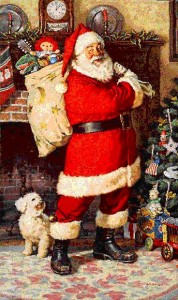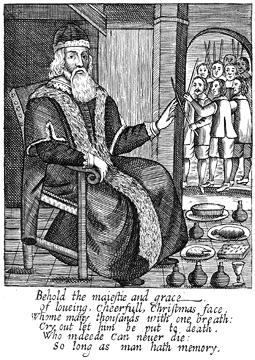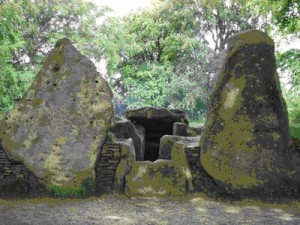The Truth About Santa Claus
Well, it’s that time of year again: the shadows lengthen, the temperatures dip even further, and the night sky seems blacker than ever. As always, this is the time for rituals. Soon we’ll engage in bonfires, feasts, and all manner of merriment against the creeping dark.

But there is one champion of this merriment who’s been slighted by modernity. Just as we determinedly pull all the teeth from fairy tales, removing any trace of murder, sacrifice, and sex, this same enthusiastic censorship has made a victim of Santa Claus. Or, depending on where you are, Father Christmas, Saint Nicholas, Papa Noel, or any number of other seasonal titles.
We all have a general concept of Santa Claus. He is a fat, jolly old man who travels the world on Christmas Eve delivering presents to all the good boys and girls of the world. But this is far from the real Santa, who is forgotten, but not gone. The real Santa – or, perhaps better, the figure who inspired him – is not the commercialized, jovial octogenarian we now see on every can of Coke at the store. Rather, he is a Yule-being of considerable power, and he has his own history that is surprisingly more fantastic and primitive than most would expect. Let’s contrast our current beliefs about Santa with the original.
1. Santa is a jolly old fat man with a big white beard and a red suit.

1.1 Santa is old, certainly. After all, he has been around for several centuries, at least. But he is not simply any jolly old man: one need only look at his beard and robes to realize that originally he was a king, of a sort, much like Clovis or Charles Martel. The “Father” Christmas title is actually inappropriate: he is said to rule over the Yule time, so the correct title would be “Yule King.” As kings have lost their allure over the years, generations have attempted to forget about this aspect of him, but the vestments of his position still persist, in one form or another. Yet the most curious thing is his choice of color: he does not wear purple, the traditional color of royalty, but a bright, visceral red. Reasons for this vary: some historians hold that his robes have been turned red by the fires of his many furnaces (see 3.2), or that the color symbolizes the persistence of life in all its violent glory (see 4.2), even in the depths of winter. There is even some belief that the color refers to his rather grisly and very real past as a king, but this is difficult to determine as the Yule King has not made an appearance on a battlefield since the early 14th century, and even that is not certain.
1.2 Like any medieval king, the Yule King’s right to power comes mostly from force of arms. As such, he is an exceedingly large person, with his height being reported at anywhere from six and a half feet to nine feet (presumably this is hyperbole, but one can never be sure). No record ever describes him as jolly, or jovial, or anything so tame. Rather, he is a fearsome and vigorous figure of no small threat, and though he has a beard, it is not of the fluffy white variety, as is so often depicted (see 2.2).
2. Santa Claus lives in a workshop at the North Pole.

2.1 This is not quite correct. Reports indicate that the Yule King does not live at the North Pole, but rather underneath a frigid mountain that forms the top of the world. It is similar to Olympus, but much starker and with much more brutal weather. And the King does not actually live there, but instead sleeps in an enormous cavern in the very heart of the peak. The nature of the cavern is a subject of some debate: some believe it is like an ornate tomb or dour cenotaph, while others claim it is filled with the statues of the King’s many servants, while others contend that it is filled with gears and machinery (see 3.1 below). Some suggest it is a bit of all of them. This can easily be believed, as the Country in the North (as it is called) is reported to be a very strange and dangerous place; some reckless adventurers who traveled there returned years later full of confusing stories, yet the strangest thing was that they did not seem to have aged a day.
2.2 The Yule King’s beard, oddly enough, is closely linked to his chamber: as he sleeps for the remaining 361 days of the year (see 4.3) the beard continues to grow, eventually filling the entire room and providing much-needed insulation against the bitter winds that swirl throughout the Country in the North. When he wakes, his servants trim it back. The insulation is not actually necessary – the Yule King would sleep anyway – but it ensures that he will be well-rested, putting him in a good mood and making his Yuletide foray much better for everyone. For example, there have been only two known instances of the Yule King killing anyone on his Yuletide foray since his servants started allowing his beard to grow out in 1351.
3. Santa’s workshop builds toys all year long, and he loads up his sleigh on Christmas Eve.
 3.1 The idea of Santa’s workshop probably comes from some confusion over the nature of his sleeping chamber. A very popular record says that the snowy peak on his mountain stays frozen throughout the year until the winter solstice approaches. When the light begins to fade from the sky, the snow there does the precise opposite of what you would expect: rather than staying frozen, it is melted by the growing dark. (Some sources indicate that it is melted by a particular blend of starlight, created only when certain constellations are arranged above the mountain, which happens only at the solstice; regardless, the effect is the same.) The melted water then runs down the mountain and is funneled into many carven flutes and passageways, which eventually end in the Yule King’s sleeping chamber.
3.1 The idea of Santa’s workshop probably comes from some confusion over the nature of his sleeping chamber. A very popular record says that the snowy peak on his mountain stays frozen throughout the year until the winter solstice approaches. When the light begins to fade from the sky, the snow there does the precise opposite of what you would expect: rather than staying frozen, it is melted by the growing dark. (Some sources indicate that it is melted by a particular blend of starlight, created only when certain constellations are arranged above the mountain, which happens only at the solstice; regardless, the effect is the same.) The melted water then runs down the mountain and is funneled into many carven flutes and passageways, which eventually end in the Yule King’s sleeping chamber.
3.2 The chamber is powered by what is called the Yule Wheel, which is redundant: “yule” generally translates into “wheel,” referring to the wheel of the seasons, so the name “Yule Wheel” actually means the “Wheel Wheel.” Whatever the name, the melted waters from the peak of the mountain drip down and cause the wheel to begin turning, and the wheel is so massive that its turning stokes the many furnaces throughout the King’s chamber, which are maintained by his servants. As the chamber gets hotter and hotter, the Yule King awakes, though due to his extreme bulk this can take most of a day.
3.2.1 It is a matter of some contention as to whether or not the Yule King actually sleeps: some historians believe he is physically dead throughout the year, and is resurrected on the winter solstice. If true, this may account for the Yule King’s longevity, which seems to border on immortality. There is little question in regards to his servants, however: most sources agree that they are either the spirits of his conquered dead, or some other type of Yule-being that he has summoned. In the latter case, they would not truly qualify as undead, having never been alive, but they would be no less an abomination.
3.3 The Yule King does not have a sleigh or reindeer, but rather a large, sturdy goat with obsidian-black antlers and red eyes. It is an uncommonly muscular and frightening specimen, and though history does not indicate whether there were ever such a thing as a “martial goat” or a “war goat,” if there were then the Yule King’s goat would surely qualify. As to the matter of toys, this is patently untrue. Nothing about the Yule King concerns children, and children should not be concerned with the Yule King at all, except possibly to fear him.
 4. Once Santa’s sleigh is loaded with toys, he flies around the world, dropping down chimneys to put presents under the Christmas tree of every good child, though he will leave coal or a switch for bad ones.
4. Once Santa’s sleigh is loaded with toys, he flies around the world, dropping down chimneys to put presents under the Christmas tree of every good child, though he will leave coal or a switch for bad ones.
4.1 As stated in 3.3, the Yule King’s affairs in mortal life do not concern children, at least not directly. The period of January through March is one of extreme danger, when livestock and crop cannot be maintained and starvation is almost unavoidable. Those facing these awful months often slaughter what cattle and pork they have, since they will not be able to feed their animals, and they engage in the last bit of merriment they will see for the season. It is said that all those who slaughter what they have left and begin to feast are engaging in Yuletide, and so are indirectly under the domain of the Yule King.
4.2 The Yule King, attracted by the recent sacrifice, will visit his followers in their sleep, reach into his copper fleischkasten, and, rather than toys, will produce salted meats and clay jugs of a very stout, potent ale. With these presents, the family that has engaged in Yuletide now has a marginally better chance of surviving the oncoming winter. These gifts have not changed since the Yule King’s first appearance sometime in the 10th Century. While these gifts are not considered appropriate in our modern times, it is generally agreed there are no adverse effects for a child imbibing the Yule King’s gift-ale, and many parents had positive things to say about its soporific effects.
4.2.1 Some claim that the Yule King visits the Yuletide festivals expecting some treat or favor of his own, like any other partygoer. As such, there are stories of merry-makers leaving packages of sweetmeats and spiced wines outside of their doors at night. Others, adhering to the more savage tales about the King, will make a bowl out of a pig’s skull and place the kidneys and liver within it and set it on a low fire at the end of the night. Whichever you believe, it seems unlikely that the Yule King would be very pleased by cookies or biscuits.
4.3 In addition, the Yule King does not visit only on one night. Traditionally, he will visit for every night that the feast continues. This is normally about three days, though in 1357 one village attempted to extend the King’s gifts for as long as possible, serving very small portions once a night and hoarding his salted meats and ales. The King, being no fool, did not react well. (See 2.3 above.)
4.4 It is unknown where the stories of chimneys, coal, and switches come from. There is no record of the Yule King ever having an issue with using the door. And while it would seem obvious that the coal and chimney have some connection to the Yule King’s many furnaces and machineries, there have been no sources confirming this. Concerning the switches, many interpret their meaning as metaphorical: those who have not engaged in Yuletide will not be visited by the Yule King, and so will no doubt feel the icy branches of winter on their backs. As for his standards of good and bad, it’s likely that the Yule King, having once been a medieval general, has moralities and philosophies wildly different from our own. Accounts of his appearances in Norse records are exceedingly vicious, often detailing his exuberance for torture and violence, but that was the norm in those primitive times, so he must be excused.
There is much more to the history of the Yule King – his participation in certain mortal wars, the ongoing feud he held with Boreas, the North Wind, or the disaster in 1421 when his servants broke out of the mountain and claimed a sizeable amount of Siberia as their own kingdom, for example – but this general overview should help anyone understand how our perception of him has changed.
However, there are bound to be some questions.
This Santa doesn’t seem very nice. Why does he deliver presents at all?
There are several ideas explaining this. One story tells that when Christianity and the Mother Church spread northwards, it naturally brought its chief antagonist with it, trying to dissuade the converted. (One can see that Lucifer makes increasingly common appearances in European history starting around 800 A.D., and ending sometime in the late 17th Century.) The Yule King, who after all was not a compassionate sort, was not much inclined to submit to Christianity’s peaceful teachings. Lucifer, seeing the chance to earn the favor of such a powerful king, attempted to win him over; but the Yule King resisted him as well, and Lucifer cursed him with frozen sleep for his stubbornness. But the King had suspected such a maneuver, and set safeguards in place that would allow him to aid his people even in this state. Thus he is only allowed to awake once a year, and, being a good king (though not a nice king), he tries to make the most of it.
Others say that this is all a lot of hogwash, and the King’s business is his own and not for us to know.
I thought Saint Nicholas was Christian.
Saint Nicholas is Christian, yes. The Yule King is not. As centuries go by, many traditions and beliefs tend to be adopted by another. Such is the case with the Yule King.
I celebrate Christmas, and I’ve never been visited by the Yule King.
Unless you have slaughtered all of your livestock on the solstice, it’s unlikely that the Yule King would bother to visit you. We have heated barns now, so our farmlands are not dampened by blood every winter’s solstice.
However, there is one account of the Yule King appearing in northern Michigan in 1911, when one desperate farmer killed his last sow on December 23rd. The next morning, he told local townsfolk that the previous evening an extremely large, terrifying man dressed in red had strode out of the woods and joined him before his fireplace. The stranger had given him beer and salted meats, and (though he spoke an incomprehensible language) he seemed to encourage the poor farmer, telling him not to lose hope, before disappearing in the morning. The farmer’s neighbors thought him mad, but his farm survived the winter, and indeed flourished in the spring, though they decided this had to be coincidence.
Well, the Yule King might not have visited me, but I did get presents from Santa this year. How do you explain that?
It’s your parents, obviously. There is no Santa Claus. Didn’t you know?
